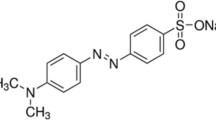Abstract
The enhancement of the nonlinear properties of materials is an interesting topic since it has many applications in optical devices and medicines. The Z-scan technique was used to study the values of the two-photon absorption (β), second-order molecular hyperpolarizability (γR), third-order susceptibility (χR), and nonlinear refractive index (n2) of Alizarin Red S in different media using a continuous-wave diode-pump laser radiation at 532 nm. For Alizarin Red S in a droplet, the β, n2, χR, and γR were estimated at the order of 10−7 cm2/W and 10−12 cm/W, 10−3 m3 W−1 s−1 and 10−24 m6 W−1 s−1, respectively. The results indicated that the values of β and n2 reduced, whereas the values of χR and γR were enhanced when the solvent was changed from droplet to water, DMF, and dimethyl sulfoxide due to the change in the solvent’s dielectric constant (ε). Moreover, the values of β were enhanced by an increase in the concentration of the surfactant in the aqueous solution. The absorption spectra of Alizarin Red S in the aqueous solution was observed at 428 nm, and a few red shifts in the absorption spectra were observed with a reduction in the dielectric constant of the medium. The same effect was observed in the absorption spectra of Alizarin Red S in the droplet when the bulk dielectric constant reduced. The dielectric constant can affect the fluorescence spectra of Alizarin Red S when the solution is changed from water to dimethyl sulfoxide. The dipole moments of Alizarin Red S in the different media were studied using the quantum perturbation theory.













Similar content being viewed by others
References
Ding F, Liu W, Diao J-X, Suna Y (2011) Characterization of alizarin red S binding sites and structural changes on human serum albumin: a biophysical study. J Hazard Mater 186:352–359
Chen Z, Wang Z, Chen J, Chen X (2012) Alizarin redS/copper ion-based ensemble for fluorescence turn on detection of glutathione with tunable dynamic range. Biosens Bioelectron 38:202–208
Bo L, Zhou Y, Wang J, Yang Z, Chen Z (2013) Application of excitation and emission matrix fluorescence (EEM) and UV–vis absorption to monitor the characteristics of alizarin red S (ARS) during electro-Fenton degradation process. Chemosphere 93:2805–2813
Zaggout FR, Qarraman AE-FA, Zourab SM (2007) Behavior of immobilized alizarin red S into sol–gel matrix as pH sensor. Mater Lett 61:4192–4195
Suzuki Y, Sugaya T, Iwatsuki S, Inamo M, Takagi HD, Odani A, Ishihara K (2017) Detailed reaction mechanism of Phenylboronic acid with alizarin red S in aqueous solution: re-investigation with spectrophotometry and Fluorometry. ChemistrySelect 2(10):2956–2964
Kubo Y, Ishida T, Kobayashi A, James TD (2005) Fluorescent alizarin–phenylboronic acid ensembles: design of self-organized molecular sensors for metal ions and anions. J Mater Chem 15:2889–2895
Zhang L, Dong S, Zhu L (2007) Fluorescent dyes of the esculetin and alizarin families respond to zinc ions ratiometrically. Chem Commun:1891–1893
Villamil-Ramos R, Yatsimirsky AK (2011) Selective fluorometric detection of pyrophosphate by interaction with alizarin red S–dimethyltin(IV) complex. Chem Commun 47:2694–2696
Rosu M-C, Suciu R-C, Lazar MD, Bratu I (2013) The influence of alizarin and fluorescein on the photoactivity of Ni, Pt and Ru-doped TiO2 layers. Mater Sci Eng B 178:383–390
Wang XH, Peng HS, Yang W, Ren ZD, Liu XM, Liu YA (2017) Indocyanine greenplatinum porphyrins integrated conjugated polymer hybrid nanoparticles for near-infrared-triggered photothermal and two-photon photodynamic therapy. J Mater Chem B 5:1856–1862
Xia T, Sheik-Bahae M, Said AA, Hagan DJ, Van Stryland EW (1994) Z-scan and EZ-scan measurements of optical nonlinearities. J. Nonlinear Opt Phys Mater 3(4):489–500
Azarpour A, Sharifi S, Rakhshanizadeh F (2018) Nonlinear optical properties of Crocin: from bulk solvent to Nano-confined droplet. J Mol Liq 252:279–288
Peyghami S, Sharifi S, Rakhshanizadeh F, Alizadeh K (2017) Nonlinear optical properties of rose Bengal: effect of environment. J Mol Liq 246:157–165
Shavakandi SM, Alizadeh K, Sharifi S, Marti O, Amirkhani M (2017) Optical study of xanthene type dyes in nano-confined liquid. J Phys D Appl Phys 50:155301–155310
Vahedi K, Sharifi S, Alizadeh K, Marti O, Amirkhani M Enhancement of nonlinear optical response and fluorescence spectra of cationic neutral red by anionic surfactant. Opt Quant Electron
M. Pourtabrizi, N. Shahtahmassebi, A. Kompany, S. Sharifi, Enhancement of linear and non-linear optical properties of Erythrosin B by Nano-droplet, Opt Quantum Electron ()
Amirkhani M, Sharifi S, Sérgio S, Funari OM (June 2014) Depletion induced sphere-cylinder transition in C12E5 microemulsion: a small-angle X-ray scattering study. Mol Phys 112(12):1702–1709
Sharifi S, Doodman E (2014) Network of Nano-droplets by a tri-block polymer. Opt Spectrosc 117(5):807–813
Sharifi S, Jensen GV, Pedersen JS, Marti O, Amirkhani M (2014) The mixture of poly( propylene-glycol)-block-poly(ethylene-glycol)-block-PPG with C12E5 microemulsion. Phys Chem Liq 52(1):113–121
Sharifi S, Marti O, Funari SS, Amirkhani M (2013) The effect of different polymer length on water droplets of reverse AOT microemulsion. Phys Chem Liq 51(5):586–594
Wang C-K, Ke Z, Yan S, Ren Y, Zhao X (2003) Solvent effects on the electronic structure of a newly synthesized two photon polymerization initiator. J Chem Phys 119(2):1208–1213
Bairu S, Ramakrishna G (2013) Two-photon absorption properties of chromophores in micelles: electrostatic interactions. J Phys Chem B 117:10484–10491
Yi L, Norman P, Macak P, Ågren H (2000) Solvent-induced two-photon absorption of a push-pull molecule. J Phys Chem A 104:4718–4722
Manohara SR, Udaya Kumar V, Shivakumaraiah LG (2013) Estimation of ground and excited-state dipole moments of 1, 2-diazines by solvatochromic method and quantum-chemical calculation. J Mol Liq 181:97–104
Sıdır YG, Sıdır I (2013) Solvent effect on the absorption and fluorescence spectra of 7-acetoxy-6-(2,3-dibromopropyl)-4,8-dimethylcoumarin: determination of ground and excited state dipole moments. Spectrochim Acta A Mol Biomol Spectrosc 102:286–296
Author information
Authors and Affiliations
Corresponding author
Rights and permissions
About this article
Cite this article
Sangsefedi, S.A., Sharifi, S., Rezaion, H.R.M. et al. Fluorescence and Nonlinear Optical Properties of Alizarin Red S in Solvents and Droplet. J Fluoresc 28, 815–825 (2018). https://doi.org/10.1007/s10895-018-2245-0
Received:
Accepted:
Published:
Issue Date:
DOI: https://doi.org/10.1007/s10895-018-2245-0




